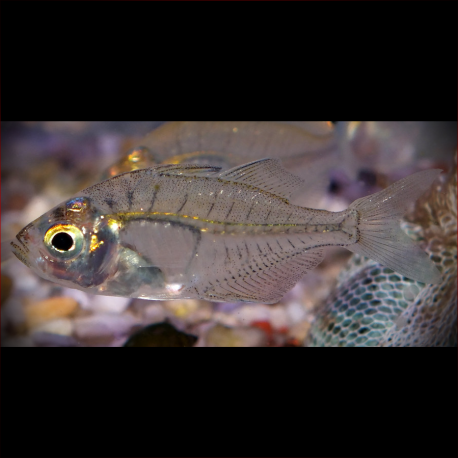More info
Datasheet
| Minimum Tank Size | 72 litres / 19.02 US gallons |
| Maximum Size | 8.0cm / 3.15inches |
| Temperature | 20°C / 68.00°F - 30°C / 86.00°F |
| Hardness | 8-20ºdH |
| pH | 6.5-8.0 |
Aquarium Setup
P. ranga thrives in a tank with a dark substrate to reduce nervousness and showcase its vibrant colors. Providing dense plant cover, floating vegetation, rocks, and driftwood creates an ideal environment for this shy species. The fish is adaptable to both freshwater and slightly brackish conditions, with specific water parameters ranging from a hardness of 8-20 degrees dH, pH of 6.5-8.0, and a temperature between 20-30 degrees Celsius (see table).
Behaviour
Peaceful and timid, P. ranga is best housed with non-aggressive species to prevent stress. In freshwater setups, compatible tankmates include barbs, livebearers, smaller rainbowfish, and loaches, while mollies, bumblebee gobies, and chromides suit brackish aquariums. As a shoaling species, Indian glass fish thrive in groups of at least six, though males can exhibit territorial behavior during spawning without causing harm.
Feeding and Diet
Indian Glass Fish are relatively undemanding eaters and will readily consume live, frozen, and dried foods. Maintaining a varied, high-quality diet is essential for their health and wellbeing in the aquarium.
Reproduction & Dimorphism
Reproduction of P. ranga is achievable with proper care, although raising the fry can be challenging. Breeding requires a heavily planted tank, conditioning with a diverse diet, and triggering spawning with strategic water changes and temperature adjustments. Males display distinct blue edging on fins and a deeper yellow hue compared to females, especially when breeding. Fry are sensitive and difficult to raise, relying on drifting food sources like brine shrimp nauplii for sustenance.
Habitat and Distribution
Primarily found in slow-moving or stagnant waters, P. ranga inhabits regions in India, Pakistan, Nepal, Bangladesh, Myanmar, Thailand, Malaysia, Cambodia, and Japan. This species is commonly encountered in freshwater habitats, although it can adapt to mildly brackish conditions where necessary.

